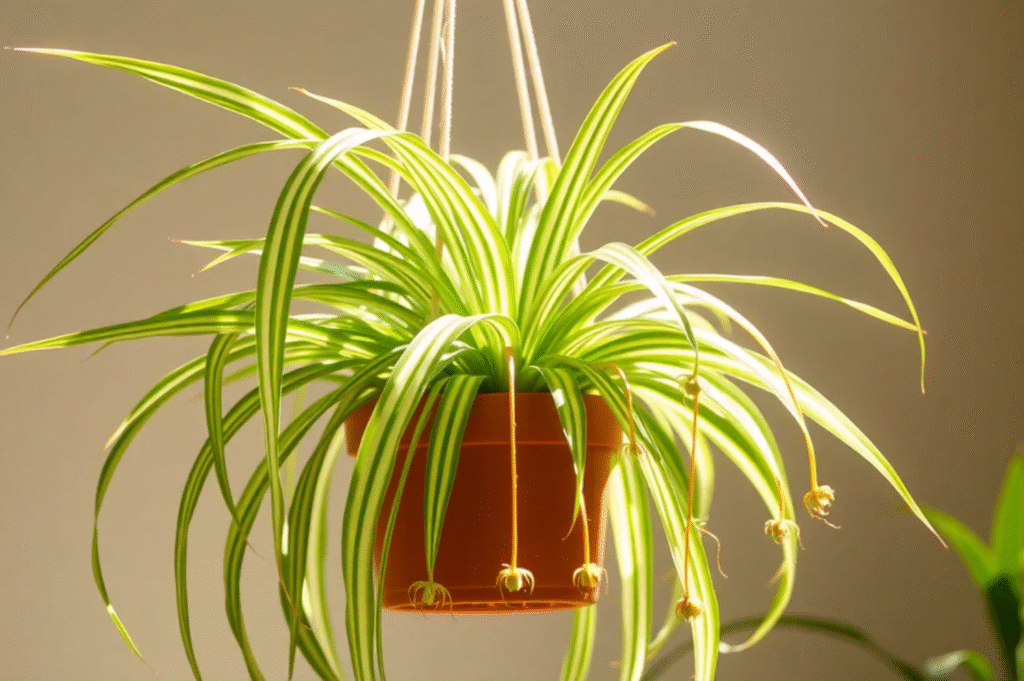Spider plants (Chlorophytum comosum) are one of the most popular houseplants around the world. They’re easy to care for, beautiful, and can grow well in different types of indoor environments. But one important thing to get right is lighting.
In this article, we’ll explain exactly how much light a spider plant needs, what kind of light is best, and how to tell if your plant is getting too much or too little. Let’s get started!
About Spider Plants
Spider plants, also known as airplane plants, are tropical houseplants native to South Africa. They’re famous for their long, arching leaves and tiny baby plants (called plantlets) that grow from the parent plant.
These plants are tough and adaptable, making them a great choice for both beginners and experienced plant lovers.
How Much Light Does a Spider Plant Need?
A spider plant needs bright, indirect light for healthy growth. Direct sunlight can scorch its leaves, while very low light can slow down its growth and cause pale, weak foliage. Place it near a window with filtered light or in a well-lit room.
What Kind of Light Does a Spider Plant Need?
Spider plants love bright but indirect sunlight. This means they should be placed in a spot where they get lots of natural light, but not direct rays from the sun. Direct sun can be too harsh and cause the leaves to turn brown or develop sunburn spots.
Ideal light sources for spider plants:
- Near a north-facing or east-facing window
- A few feet away from a bright south-facing window with sheer curtains
- A room with good natural daylight throughout the day
Can Spider Plants Handle Direct Sunlight?
No! Spider plants don’t like full, direct sun. If placed in direct sunlight for several hours, the leaves can get scorched, leading to brown tips and patches.
If your only option is a sunny windowsill, use a light curtain or move the plant a little further from the window.
How Do I Know If My Spider Plant Is Getting Too Much Sun?
If your spider plant is exposed to too much light, it will start showing these signs:
- Brown or crispy leaf tips
- Yellowing leaves
- White or faded spots on leaves (leaf burn)
- Drooping or dry foliage
If you notice any of these, move your plant to a shadier, indirect light spot immediately.
Can Spider Plants Grow in Low Light?
Yes, spider plants can survive in low light, but they won’t thrive. In dim environments, their growth will slow down, and the leaves might lose their bright green color.
In very low light, the plant may:
- Grow fewer new leaves
- Develop pale, dull, or weak foliage
- Look stretched out or “leggy”
To help your spider plant stay healthy, place it in a room that gets natural daylight or use artificial lighting if needed.
Artificial Lighting for Spider Plants
If your home or office doesn’t get enough natural light, spider plants also do well under artificial lights. You can use LED grow lights or regular fluorescent bulbs.
Make sure the plant gets around 12-14 hours of light a day from these sources. Place the lights about 6–12 inches above the plant for best results.
How to Fix a Spider Plant Getting Too Little Light
If your spider plant isn’t getting enough light:
- Move it to a brighter spot in your home.
- Clean the leaves with a damp cloth to help them absorb more light.
- Use artificial lighting to supplement natural daylight.
- Rotate the plant regularly so all sides get equal light.
Within a few weeks, you’ll notice the leaves perking up and new growth starting.
Conclusion
So, how much light does a spider plant need? The answer is bright, indirect sunlight for most of the day. Avoid placing it in direct sunlight, and don’t leave it in dark corners for too long.
A well-lit, cozy spot by a window with filtered sunlight is perfect for keeping your spider plant happy, healthy, and growing beautifully.





